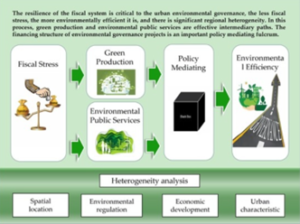Let us deploy fiscal federalism against climate change.
Relevance
- GS Paper 3
- Conservation, environmental pollution and degradation, environmental impact assessment.
- Tags: #climatechange #suatainabledevelopment #fiscalfederalism #India #Life #currentaffairs #upsc.
Why in the News?
- India has made important global commitments to cut its emissions to net zero by 2070, with a rising share of renewal energy among the milestones set for the path towards this target. In managing the transition, it is time to place a lens of fiscal federalism on environment policy.
- The global approach to utilizing fiscal federalism for climate action has been a topic of increasing importance. In India, the landscape of environmental policy has long been centralized.
- However, the current reality demands a shift towards greater involvement of Indian states in climate change adaptation and mitigation efforts. To align with this evolving scenario, the establishment of new federal institutions is imperative to rebalance governance capacity between the Centre and states.
The Constitutional Framework
- The Indian Constitution designates the Centre as the primary authority in key aspects of climate governance, including mines, petroleum, industry, and inter-state waters.
- Meanwhile, the concurrent list covers various other domains, such as forests, wildlife, factories, and electricity. Notably, areas like local government, agriculture, and water governance fall under the purview of state governments.
Historical Approach and Challenges
- Historically, the Centre has dictated the framework within which states operate, primarily through the National Action Plan on Climate Change (NAPCC).
- This plan has established eight national climate action goals, with each state subsequently crafting its State Action Plan on Climate Change (SAPCC).
- However, these SAPCCs lack coordination, vary in approach, and often lack alignment with the Centre’s net-zero targets.
- State-level policies have largely been shaped by national schemes and centrally designed model legislations, channeled through institutions like the National Steering Committee on Climate Change (NSCCC) and other forums.
Recommendations for Strengthening Fiscal Federalism
To enhance the use of fiscal federalism for climate change in India, several key strategies should be considered:
- Define Activities and Climate Finance Channels: India should expand its efforts to map climate-related programs in states along with their associated funding channels, building upon the initiatives of Niti Aayog.
- Enhance Fund Allocation: A significant proportion of funds should be allocated to states through fiscal federal mechanisms specifically earmarked for climate-related initiatives and renewable energy projects.
- Strengthen State Capacity: Institutional mechanisms must be reinforced to enable effective planning, implementation, and monitoring of climate initiatives. The National Mission on Strategic Knowledge for Climate Change can be a starting point.
- Incentivize Climate Action: India can introduce performance-based incentives for states that make substantial progress toward climate goals. Additional grants could reward states achieving emissions reduction or increased renewable energy generation.
- Mainstream Climate Finance: Integrating climate finance into state fiscal planning processes is vital to ensure climate considerations are embedded in state budgets.
- Harmonize Policy: India should establish systems for policy and regulation harmonization across states, providing stability for businesses, investors, and stakeholders. The Centre can facilitate coordination and knowledge exchange among states.
- Boost Data and Monitoring Systems: Robust data collection, management, and monitoring systems at the state level are essential. This includes improving data quality, establishing monitoring and evaluation frameworks, and promoting transparency.
- Promote Public-Private Partnerships: Leveraging private capital and expertise through fiscal incentives, innovative financing models, and risk-sharing arrangements can accelerate climate action projects.
- Enhance the Finance Commission’s Role: The 16th Finance Commission, and future ones, can play a pivotal role in distributing funds to subnational levels for climate action. This mandate should consider equity among states and the evolving ecological challenges.
Conclusion
By implementing these recommendations, India can fortify the role of fiscal federalism in addressing climate change. This approach will optimize financial resources, bolster state capacities, foster policy coherence, and drive sustainable development throughout the country.
| Initiatives taken by India to deploy fiscal federalism against climate change
· National Adaptation Fund for Climate Change (NAFCC): The NAFCC was established in 2015 to provide financial assistance to states and other stakeholders for adaptation measures to climate change. The fund is replenished every five years through a levy on coal production. · Green India Mission (GIM): The GIM was launched in 2014 to promote sustainable forest management and restoration. The mission provides financial assistance to states for afforestation, reforestation, and other forest conservation activities. · National Clean Energy Fund (NCEF): The NCEF was established in 2010 to promote renewable energy and energy efficiency. The fund is used to provide financial assistance to states for renewable energy projects and energy efficiency measures. · UJALA Scheme: The UJALA Scheme was launched in 2015 to promote the use of energy-efficient LED bulbs. The scheme provides financial assistance to states to procure and distribute LED bulbs to households and other consumers. · Pradhan Mantri Kaushal Vikas Yojana (PMKVY): The PMKVY was launched in 2015 to skill youth for green jobs. The scheme provides financial assistance to states to train youth in various green technologies.
|
Sources: Livemint
Mains Question
“Discuss the role of fiscal federalism in India’s climate change mitigation efforts, highlighting the challenges faced and potential solutions, as outlined in the article.” (250 words)”





